

1985 - Laserwriters, Networks and Animation Tools, Oh My! |
|
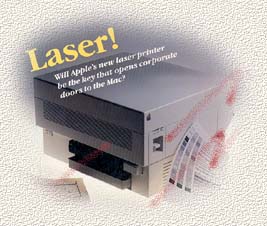 Late 1984 and early 1985 were pretty lean times for the new Mac platform. Little new software had shipped and sales of the Macintosh were slowing down. The Fat Mac 512K had come out in the fall of '84 injecting a little life into the Mac by providing a whopping four times the amount of memory as in the original. This made it much easier for software developers to get their code to fit in memory and actually run. The result was a flood of new products later in 1985.
Late 1984 and early 1985 were pretty lean times for the new Mac platform. Little new software had shipped and sales of the Macintosh were slowing down. The Fat Mac 512K had come out in the fall of '84 injecting a little life into the Mac by providing a whopping four times the amount of memory as in the original. This made it much easier for software developers to get their code to fit in memory and actually run. The result was a flood of new products later in 1985.
The Laserwriter PrinterIt was the introduction of the Laserwriter printer in early 1985 that truly saved the Macintosh from extinction. The Apple Laserwriter combined with Adobe's Postscript was the torch that would ignite the Desktop Publishing revolution. The Laserwriter was a 300 dpi laser printer that cost $6995 when it was released. This was actually a very cost effective business printing solution that could produce high quality documents in-house. It made the Macintosh a must have tool for designers, illustrators and publishers. Desktop publishing was the "Killer App" that created a demand for devices which could create high quality digital pictures. Ultimately, leading to digital photography. Many Silicon Vallery firms realised this early on, it took Kodak awhile to come to the same realization. Viewing photos on your TV still had it's proponents, and they were heavily invested.The other significant product innovation Apple introduced at the same time was Appletalk networking. Now, using these thin little wires and connectors you could connect several Macs and the Laserwriter printer together and send files to the other Macs or to the printer. Small group computing had arrived. The Macintosh OfficeIt dawned on me that the Mac technology could be applied to my job at Kodak, to reduce work and streamline workflow. A large part of our job as quality test technicians was collecting test data and then writing reports of our findings. Data most often was collected from LED readouts on various test equipment and then transposed to paper. We had several mainframes that were used to run some of the test equipment, but they output directly to teletype machines and the resulting single copy had to be included in the report. 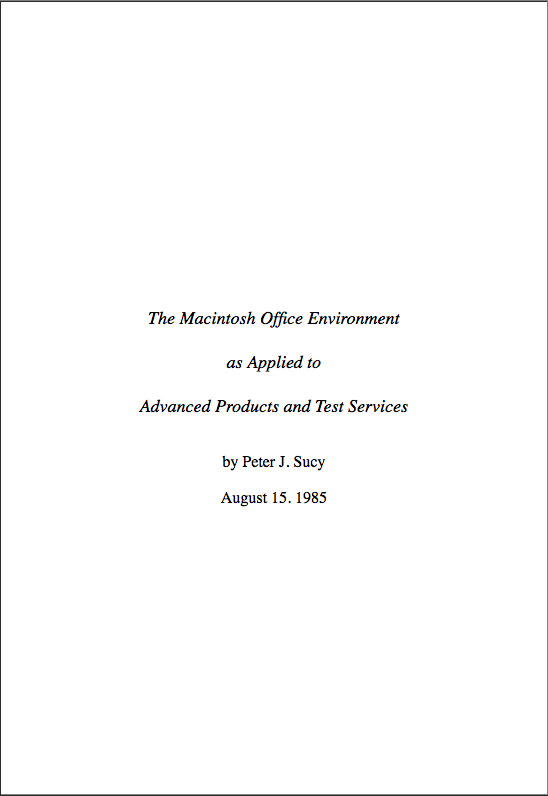 

In 1985 the test reports were hand written on triplicate carbon copy paper so that a copy could be mailed to the engineering department along with the various teletype printouts. My hands would get very sore after having rewritten a test report over several times because the group leader thought it had too many crossouts. An example of the excessive creation of busy work that was pervasive at Kodak. 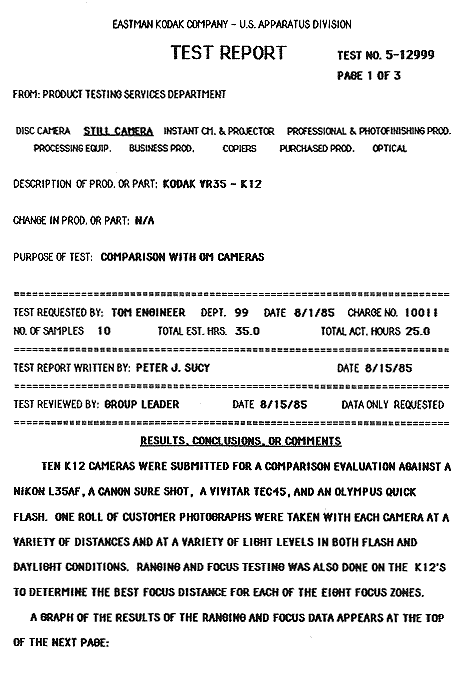 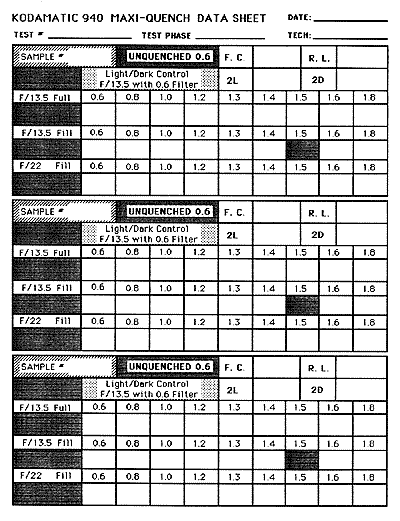 
It seemed to me that we could save reams of paper and time, if we connected a bunch of these Macs together in both the QA lab and the engineering department. We could fill out the reports as forms, and then send these forms electronically to the engineering department where the engineer could review it almost instantly. I also figured that there must be a way to connect the Macs to the test equipment in order to collect the data for input directly into the report, rather than tediously transposing the data. Working just a few late nights at it, I drew up a brief proposal for implementing my version of the Mac Office in the QA lab. I thought I did a fairly good job spelling out the pros and cons, the applications, illustrating the concept, and outlining the costs. I even created a number of sample documents such as test reports, and various test results including charts, data sheets and graphs. My Mac Office plan was finally implemented in the QA lab about 2 years after I left, which coincidently was just shortly after the time limit for my original suggestion had expired. The supervisor who had turned it down had, resubmitted the idea as his own and gained the suggestion reward. It wasn't the first time and it wouldn't be the last. A New Job
For the first time in ten years at Kodak I found myself working in an entirely new and stimulating environment. I was surrounded by a group of very talented people who had a real passion for the work that they were doing and who were still willing to take the time to answer my questions. It was actually exciting to go to work and learn how all this new electronic stuff worked. As I learned I began to envision new ways to apply these technologies. I was a little unsure of putting forward my ideas at first but I found most of these people were willing to listen to your ideas no matter what your title. Jerry B., (the engineer I'd been assigned to) and I had begun to figure out a way to calibrate the printer using some photo sensors and a brand new digital oscilliscope. By accurately measuring the amount of light at the film plane, we hoped we could use these sensors to create a calibration tool that could be used by assembly line workers to quickly adjust the calibration pots to the desired measurement. This did help a bit. In the end however, the problem we couldn't overcome was the variability in the sensitometry of the instant film. The color balance would vary widely from the first print to the last print even within one ten pack of prints. Still Video Floppy and New Products
A new camera was also in development that could record directly onto the still video floppy, the floppy could then be removed from the camera and played back in the player. The major problem I foresaw with this technology was that the quality of the resulting images wasn't that great when viewed on a TV monitor and they looked even worse when printed on our new printer. If the intent was to market these early products to video/photo professionals I feared they would not be well received unless the quality was significantly better. In my free time I continued to experiment with MacPaint and Musicworks. I was amazed that even I could create music of a sort. The newness of the experience had still not yet worn off, I spent many a late hour tweaking sequences of those tinny sounds and just as many turning pixels on and off to create images in MacPaint. MacUser Magazine Debuts
Videoworks - Animation comes to the MacAround October my long awaited copy of Videoworks (another product that had a long vaporware stage) finally arrived. This was the product I had imagined having when I first saw the Mac. Animation has long been one of my passions. During my final semester at RIT I had the opportunity, along with several others, to visit the Film Board of Canada in Montreal. While there we witnessed one of the very first computer animated films being shot. It was pretty crude, just some stick figures really. These images were being generated by a large mainframe computer of the time. Now on a computer that I could actually afford, I had the tools to create my own computer animations. 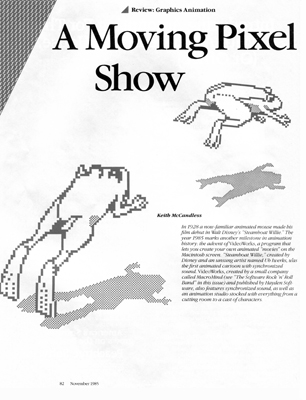
Thunderscan Scanner
Granted the images were only one bit images, but after playing with the Thunderscan software I was amazed at what could be represented with black and white dots. Below are some examples, click to see the full res MacPaint file. Impressive right?
It was awesome! Now for the first time I could bring my photographic images into the computer and edit them. I realized it wouldn't be long before there were color digitizers, full color computer monitors and software to edit images in color. 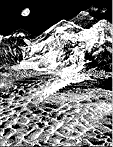
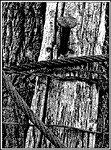
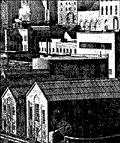

More Digitizers from 1985As if to highlight that point, vendors from Silicon Valley were announcing new ones everday. Here's a few more.  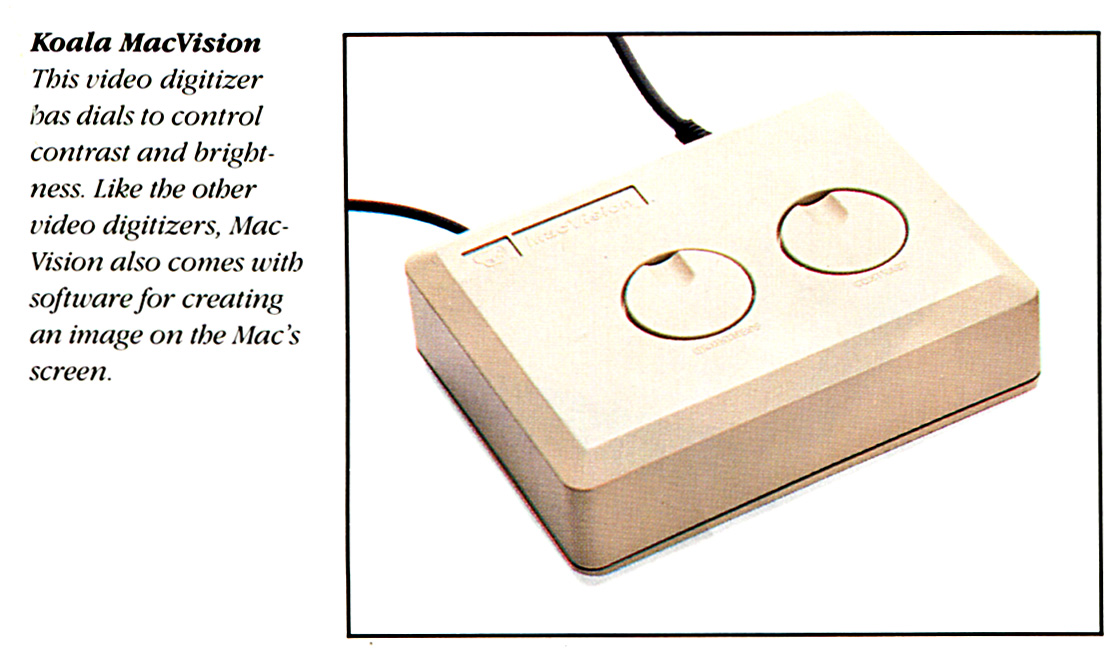  Here's a copy of the article MacWorld published in 1985 with reviews of a number of these early video digiters. Only the ThunderScan was a true scanner. 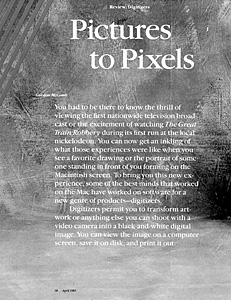
Click Image to View (requires PDF plugin) or Downlad a PDF of the full Document Where was Kodak at this point? Not even considering the personal computer as an option. Analog video was the path we were on. It looked like the Digital Revolution had started without us! Hard Drives for the Mac Begin to AppearThe Mac PlusBy December rumors were rampant that a new Macintosh (the Macintosh Plus) would be announced in January. It was said to have a minimum of 1 Megabyte of memory upgradeable to 4 whole Megabytes, a new high speed interface for connecting external hard drives and other peripherals. The year 1985 was one of great change in the computer world as well as for myself. I would not only change jobs, but we'd also just moved from our city home to a new home way out in the western suburbs. Most of all, my attitude toward Kodak had changed. I never thought I'd be at Kodak for the long term, I figured I'd just work there till I got a break doing something I really enjoyed. Now however, I was actually beginning to enjoy my work at Kodak. The new technologies I was being exposed to held great promise and it was great fun to explore. |